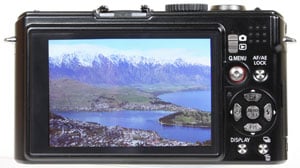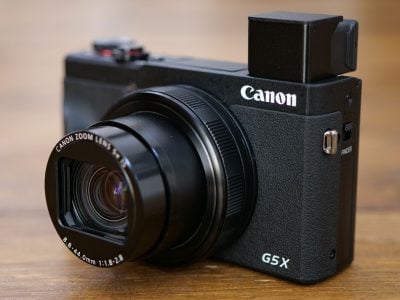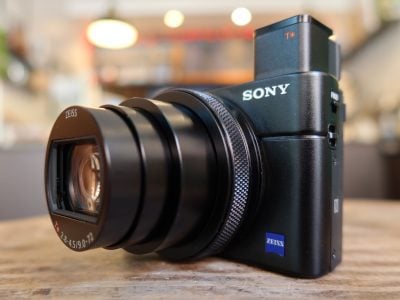Panasonic Lumix DMC-LX3
-
-
Written by Gordon Laing
Panasonic Lumix DMC-LX3 Verdict
The Panasonic Lumix DMC-LX3 is an ideal compact for enthusiasts who demand full manual control and specialist features in a small and light package. Crucially, the LX3 also addresses some of the issues concerning image quality which faced its predecessor.
We’ll kick-off with the sensor. Panasonic makes a big deal in its LX3 marketing about how small sensors and high resolutions don’t add up to superior quality, before then boasting how the LX3 has a larger than average sensor and bucks the trend for unnecessarily high resolutions. This is of course great news, but something both owners and reviewers have been requesting from the company for some time.
Panasonic has always delivered compacts with decent optics, controls and features, but has often let them down with relatively high noise levels and processing artefacts. Finally it seems the company has taken notice of feedback, and while the LX3’s sensor isn’t actually that much larger than the LX2’s, it’s certainly much bigger than the 1 /2.33in CCDs in its other compacts and crucially delivers superior output to both them and its predecessor.
Check out our results pages and you’ll see the LX3’s images still have a certain degree of background texture due to noise and image processing, which of course becomes worse as the sensitivity increases, but the output is an improvement over previous Panasonic models. Fine detail is retained at surprisingly high sensitivities and there’s little smearing to worry about – indeed our High ISO Noise results page reveals the LX3 enjoys around a one stop advantage over the Canon PowerShot G9 from 100 ISO to its maximum sensitivity. We’ve waited a long time to say this, but here’s a Panasonic compact which really does perform respectably at higher sensitivities, and careful processing of RAW files can yield even better results.
The LX3’s new lens also delivers two key benefits of extra wide coverage and bright focal ratio. As our LX3 Sample Images Gallery shows, 24mm coverage genuinely captures a noticeably wider field of view than compacts with 35mm or even 28mm coverage. The bright focal ratio of f2.0-2.8 is also a very welcome feature, and allowed us to capture shots under dim conditions at much faster shutter speeds than other compacts, thereby avoiding both camera shake and higher ISOs.
While the LX3’s tiny joystick can prove fiddly at times, the camera does at least deliver on its promise of full manual control – and unlike many compacts you can also use the fastest shutter with the widest aperture. The continued presence of RAW is also essential to anyone wanting to get the most from the camera, and the new flash hotshoe a welcome addition. And if you’re feeling lazy or spot a quick photo opportunity, there’s few automatic options which work as well as Panasonic’s Intelligent Auto.
 |
The HD movie mode is also a nice addition to the LX3 and makes the 4:3 standard definition modes of other cameras seem very old fashioned. In our tests there was still some visible noise in the 720p movies, but they were definitely cleaner than the HD video on previous Panasonic compacts, and the audio quality was improved too. As we’ve said in the main review though, it’s still no substitute for a dedicated camcorder.
So far so good, but of course it’s not all positive news. The lens may zoom wider than almost any compact and it’s brighter than most too, but the 2.5x optical range is pretty short. The earlier LX2 had a 4x zoom, while Canon’s enthusiast-level G9 and G10 enjoy 6 and 5x zooms respectively. Since each also starts at a longer focal length, this means all zoom-in much closer than the LX3, so you have to decide if the 24-60mm focal range will suit your style of photography or whether you’d prefer to sacrifice the ultra-wide angle coverage for something longer.
Sticking with the lens, it’s also infuriating to find a physical cap protecting it rather than the built-in sliding covers on other models. It slows you down when powering-up the camera and of course also runs the risk of being lost.
The decision to fit a 3:2 shaped screen on a camera with a 4:3 shaped sensor is also an interesting one. The LX3 may inherit the TZ3’s ability to maintain the angle of view when you switch aspect ratios, but the maximum resolution is only achieved when the sensor is recording squarer 4:3 shaped images. Admittedly we’re only talking half a Megapixel’s difference, but it’s still a little annoying to lose some pixels when you’re filling the nice 3:2 screen with your composition.
Then there’s the competition. Canon’s PowerShot G9 remains a compelling alternative and its new successor, the G10, finally equips it with 28mm wide angle coverage. There’s also Panasonic’s own recently announced Lumix G1 which boasts a considerably larger sensor and removable lenses, albeit at what will almost certainly be a much higher price. So without further ado, how does the Lumix LX3 measure-up?
Compared to Canon PowerShot G9
 |
Canon’s PowerShot G9 is a year older than the LX3, but remains one of the best enthusiast compacts on the market. Like the LX3 it boasts full manual control, RAW recording, a 3in screen and flash hotshoe. In its favour, the G9 sports a much longer optical range of 6x to 2.5x on the LX3, and while it doesn’t zoom anywhere near as wide at an equivalent of 35mm, it does zoom-into a respectable 210mm which is much longer than the LX3’s 60mm. The G9 also features two extra Megapixels, an optical viewfinder that’s useful at times when direct light or low battery makes the screen less than ideal, a neat time lapse mode, a built-in lens ‘cap’, and a tank-like body that feels more substantial. Judging from our results, the Canon G9 also has the edge on image quality at 80 ISO.
In the LX3’s favour are considerably wider angle coverage of 24mm to the G9’s 35mm, a lens that’s one stop brighter at f2.0 to the G9’s f2.8, widescreen movie recording including a 720p HD mode, an optional component video output to HDTVs, and a more detailed screen with 460k pixels to the G9’s 230k; the screen is also wider, but as discussed above, that’s not necessarily an advantage. Finally the LX3 is smaller, lighter, and in terms of image quality has the edge over the G9 at higher sensitivities.
Previously the LX2 lost out to the G9 on poor image quality, along with the absence of a hotshoe and optical viewfinder. With the new LX3, Panasonic’s fixed the first two and offers an optical viewfinder as an accessory. As such a lot boils down which model looks and feels best to you, along with which optical zoom range best-suits your style of photography. Ultimately if you’re shooting at 80 ISO and are careful to protect for highlight clipping we’d say the G9 delivers better image quality, but you really need to weigh up all the pros and cons to decide which will work out best for you. Now the G10 has been announced, the price on the G9 may also fall. See our Canon PowerShot G9 review for more details.
Compared to Canon PowerShot G10
 |
Canon announced the PowerShot G10 in September 2008 as we completed this review. We can’t comment on image quality until we conduct a full review of a final production model, but we can talk about the features and how they compare to the LX3.
The PowerShot G10 greatly resembles its predecessor and still sports full manual control, RAW recording, a flash hotshoe and 3in screen, but there’s a few key changes: the sensor resolution has been increased to 14.7 Megapixels, the screen detail upgraded to 460k pixels (like the LX3 but 4:3 shaped), and the lens swapped for a 5x model with 28-140mm coverage. So in its favour over the LX3 are almost five extra Megapixels, double the optical lens range (although the LX3 is still wider), a built-in lens ‘cap’, and an optical viewfinder. Some may also still prefer the brick-like build of the G10, now with an improved grip over its predecessor.
In its favour the LX3 enjoys wider angle coverage of 24mm (although the G10 is closer than before at 28mm), a lens that’s one stop brighter at f2.0 to the G10’s f2.8, widescreen movie recording including a 720p HD mode, and optional component HD output, all packed into a smaller and lighter body that’s also slightly cheaper.
With 28mm wide angle coverage though, the G10 has addressed one of the major complaints facing the G9, and while the LX3 zooms wider still, many will be willing to sacrifice a little at the wide end to gain a lot at the telephoto. The boost in Megapixels also sounds tempting in theory, but could end up compromising quality in practice – only time will tell. Discuss the Canon PowerShot G10 in the Cameralabs forums.
Compared to Panasonic Lumix DMC-G1
 |
Panasonic’s Lumix DMC-G1 is the first camera based on the new Micro Four Thirds standard. The standard, developed by Panasonic and Olympus, was announced in August 2008 and the G1 one month later. Like the Canon G10, it’s not yet on-sale so we can’t comment on image quality. But it does offer a compelling prospect to enthusiasts who want a high quality compact, so we’ve included it here.
The G1 can either be thought of as a compact with a large sensor and interchangeable lenses, or a small DSLR without the mirror and optical viewfinder. Whichever your viewpoint, the G1 – along with future Micro Four Thirds bodies – offers two big advantages over models like the Lumix LX3 and Canon G9 / G10. First is a physically much larger sensor which should allow the G1 to enjoy considerably lower noise levels at high sensitivities along with a greater dynamic range. Second is the chance to fit different lenses depending on your creative requirements. As you’d expect, there’s also full manual control, RAW recording and a flash hotshoe.
Additionally in its favour over the LX3, the G1 features two extra Megapixels, a flip-out screen (coincidentally the same size, shape and resolution as the LX3’s), alternative composition with a high quality electronic viewfinder, continuous JPEG shooting at 3fps until you run out of memory, a kit lens with a slightly longer 3.2x optical range and an HDMI output.
In its favour, the Lumix LX3 is much smaller and lighter, boasts wider angle coverage (albeit using a non-removable lens with a shorter 2.5x range), and includes a movie mode which also supports HD recording; video is coming to Micro Four Thirds in the future, but sadly isn’t present in the G1.
At the time of writing, Panasonic had not yet announced pricing for the G1, but it will be comfortably more expensive than the LX3. We’ll be reviewing the G1 when final production models are available, but in the meantime it has certainly piqued the interest of those who might otherwise consider the LX3 or G9 / G10. For more information, see our Panasonic Lumix DMC-G1 preview.
Also consider:
If you’re after a compact with DSLR quality, you should also check out the Sigma DP1. While it’s pricey and ended up disappointing in too many respects, there are those who’ll work around any issues to enjoy the unique-looking output from its Foveon X3 sensor. See our Sigma DP1 review for more details.
Panasonic Lumix DMC-LX3 final verdict
The Lumix LX3 fulfils its brief as a high-end enthusiasts compact. It ticks all the required feature boxes including full manual control, RAW recording, a flash hotshoe and wide angle lens with the bonus of a bright focal ratio. On top of this you also get a decent 3in screen with 460k pixels, HD movie recording and a raft of easy modes including Panasonic’s excellent Intelligent Auto. All this packed into a small and light body which actually comes in slightly cheaper than its closest rival from Canon.
At this point most Panasonic compact reviews come in with the big downside: noise and visible smearing at all sensitivities. But the company really does appear to have realised tiny 1 /2.33in sensors have no place in this type of product (or any half-decent compact if we had our way), and finally delivered a solution that actually out-performs the competition at higher sensitivities.
But before you get too carried away, a final reality check. While the image quality of the LX3 is indeed superior to both its predecessor and other Panasonic compacts, it’s by no means perfection even at its lowest sensitivity. If you’re looking, there’s still textures from noise and processing on most images, and while the LX3 outperforms models like the Canon G9 at higher sensitivities, the G9 delivers more detailed and cleaner output when both cameras are set to 80 ISO. Indeed if you mostly shoot at 80 ISO and are happy with its focal range, then we’d recommend the G9 over the LX3.
As for improved dynamic range, the LX3 certainly manages to avoid blown highlights at times when the Canon G9 can suffer from saturated areas, but this appears to be more down to metering than anything else. The LX3 has a habit of erring on underexposure which while certainly protecting highlights in some images, results in overly dark areas in others – see our Gallery for examples.
So like most cameras the Lumix LX3 comes with some caveats, but if you’re satisfied by the image quality, you’ll be very happy with the camera. Sure the lens doesn’t zoom-in as close as most compacts, but which models have a stabilised lens with 24mm coverage or an f2.0 focal ratio? Which models also support RAW, full manual control and offer a flash hotshoe? Which models deliver all this in a pocketable form factor while also coming in slightly cheaper than the closest competition? The Lumix LX3 may not be perfect, but it’s one of the best compacts for enthusiasts to date and if its feature set and focal range suits your style of photography, it comes Recommended.
Good points Bad points |  Scores | |||
Build quality: Image quality: Handling: Specification: Value:
Overall: | 18 / 20 17 / 20 17 / 20 18 / 20 18 / 20
88% | |||



